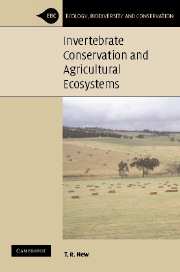Book contents
- Frontmatter
- Contents
- Preface
- Acknowledgements
- 1 Introduction: agricultural ecosystems and conservation
- 2 Agriculture and biodiversity: the place of invertebrates
- 3 Agriculture: effects on invertebrate diversity and conservation
- 4 Agricultural disturbance: diversity and effects on invertebrates
- 5 Biological control and invertebrate conservation
- 6 Cultural aspects of pest management
- 7 Extending beyond cropping areas
- 8 Field margins and landscape ecology
- 9 Pasture management and conservation
- 10 Towards more holistic management for invertebrates
- References
- Index
4 - Agricultural disturbance: diversity and effects on invertebrates
Published online by Cambridge University Press: 29 July 2009
- Frontmatter
- Contents
- Preface
- Acknowledgements
- 1 Introduction: agricultural ecosystems and conservation
- 2 Agriculture and biodiversity: the place of invertebrates
- 3 Agriculture: effects on invertebrate diversity and conservation
- 4 Agricultural disturbance: diversity and effects on invertebrates
- 5 Biological control and invertebrate conservation
- 6 Cultural aspects of pest management
- 7 Extending beyond cropping areas
- 8 Field margins and landscape ecology
- 9 Pasture management and conservation
- 10 Towards more holistic management for invertebrates
- References
- Index
Summary
Discussion of the characteristics of agroecosystems and their conventional management for crop protection helps us to focus more closely on the threats to invetebrates introduced in the previous chapter. Understanding the needs and principles of pest management is a critical theme in invertebrate conservation in agroecosystems, and the rationales of pest definition and evaluation underpin crop-protection measures. This chapter also introduces a major concern in crop protection and its incompatability with conservation: the use of pesticides that may have substantial undesirable side effects, and how these may be appraised and overcome through development of wider integrated pest-management programmes for both economic and environmental benefits.
Introduction
Agroecosystems are, essentially, ‘disturbed’ ecosystems. The disturbances are equated to varying extents with threats to the natural biota that they subsume through initial establishment and continuing management and diversification. Disturbance, very broadly, may alter the diversity within an ecosystem directly (by killing individuals) or indirectly (by changing resource quality and accessibiity). If disturbance is severe, then biodiversity tends to be reduced, because only the relatively low proportion of taxa that are insensitive to the disturbance can persist. ‘Disturbance’ can be defined as the cause of a perturbation – that is, of an effect or change in the state of the ecosystem relative to an undisturbed reference ecosystem (Rykiel, 1985).
In Chapter 1, some of the differences between agroecosystems and more natural ecosystems were discussed, but it is important also to recognise the similarities and parallels between them.
- Type
- Chapter
- Information
- Invertebrate Conservation and Agricultural Ecosystems , pp. 85 - 137Publisher: Cambridge University PressPrint publication year: 2005



